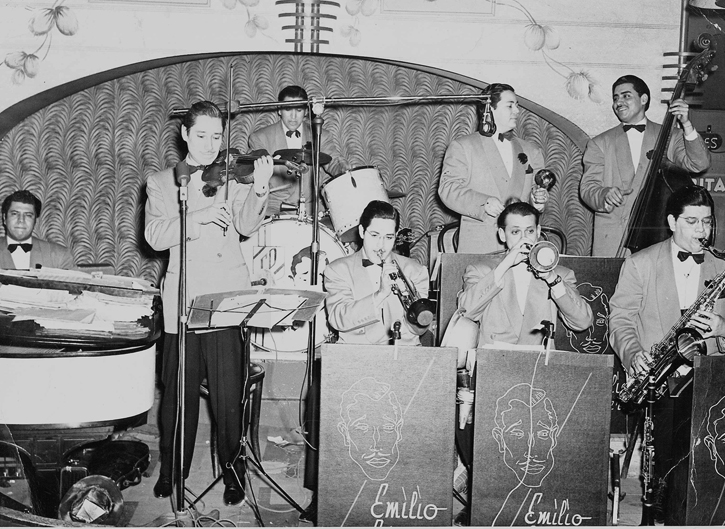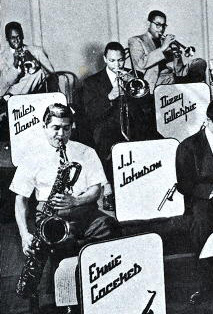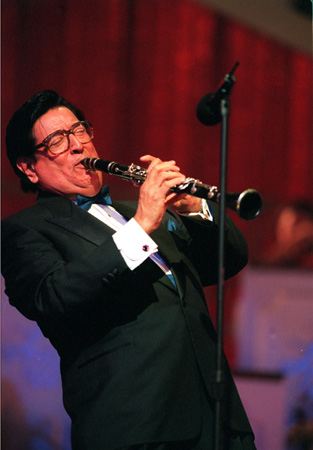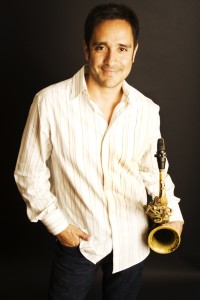Hot jazz has always found a home in San Antonio. Emilio and Ernie Caceres were its hottest exports in the 1930s. New York critics praised the brothers’ 1937 Victor recordings with Emilio swinging hard on violin, and they admired Ernie’s clarinet style, calling it “assertive and poignant” and "as smooth as Benny Goodman.”

Victor Recording Orchestra 1935. Emilio Caceres seated center; Ernie Caceres seated right. Photo courtesy Emilio Caceres.
The older of the two siblings Emilio Caceres led an influential swing orchestra in the Southwest, yet it was his small ensemble, a hot chamber jazz trio, that earned the brothers national acclaim. Supporting Emilio’s impeccable jazz violin, Ernie Caceres doubled on clarinet and baritone sax with their cousin Johnny Gomez on guitar. Their live nationwide appearances in 1937 on Benny Goodman’s popular radio series—Camel Caravan—created a sensation and made them the jazz stars of the moment. The instrumental blend of Emilio’s driving jazz violin with Ernie’s full-bodied clarinet was something new, at just the right time. The critics called their sound “astonishing” and “splendid.”
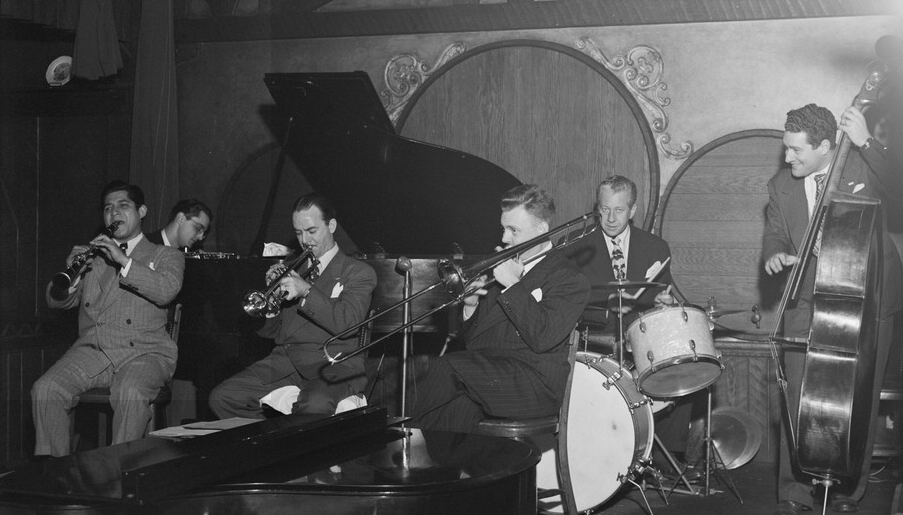
Ernie Caceres, Bobby Hackett, Freddie Ohms, and George Wettling at Nick's in Greenwich Village, 1940s. Photo by William P. Gottlieb, Library of Congress.
In New York City Emilio received the recognition he deserved, then wanted nothing more than to go back home to make music in Texas. Refusing offers of fame and fortune in the East, Emilio returned to San Antonio where he led his own big band for years and had a weekly radio show on WOAI. From his home base, Emilio continued to make hit records for the Victor and Decca labels. In 1937 he recorded one of his biggest hits—a tune he wrote and recorded with his brother Ernie, "Jig in G."
Exposure to the New York jazz scene had the opposite effect on Emilio’s brother Ernie. He loved the buzz of living in the jazz world in New York at the height of the Swing Era. He linked up with Bobby Hackett, joined Jack Teagarden's ensemble, then switched to the Glenn Miller Orchestra. After stints with Goodman and Dorsey, Ernie’s burly baritone saxophone sound became a mainstay at Nick’s in the Village and on Eddie Condon’s Town Hall broadcasts. Ernie Caceres and his good friend, trumpeter Billy Butterfield bought matching MG sports cars and roared into Manhattan from their homes on Long Island for their regular afternoon gig in the orchestra on the Gary Moore TV show.
Jim Cullum says, "My Father, Jim Sr., became fast friends with Ernie Caceres when he came back to live in San Antonio in the '60s. Besides being a great player, Ernie was a fabulous arranger, and he wrote a number of charts for our band."
Ernie established himself as a fixture on the jazz scene in his years with the Glenn Miller Orchestra. He made it into the top ten “Favorite Jazz Soloist” category in the annual Down Beat magazine poll, outranking Bobby Hackett, Coleman Hawkins and Gene Krupa. In 1949 he won a place on the Metronome All-Star Band. Ernie later recorded with Louis Armstrong and Sidney Bechet.
Featured on this week's show is a cousin of the Caceres brothers, clarinetist Henry Cuesta: "I was about nine years old when my mother took me to the movies to see Sun Valley Serenade. The movie's stars were Milton Berle and Sonja Henie, but once I heard the sound track with my cousin Ernie playing with the Glenn Miller Orchestra, the musicians became the biggest stars for me."
Another member of the Caceres family featured on this radio show is the Houston-based alto saxophonist David Caceres, a grandson of Emilio. David says, "When I play, people that recognize the name will approach me and ask if I’m related to Emilio or Ernie. When I say that I am they begin to tell me what great musicians they were and how fortunate I am to be a part of the Caceres family." David's brother Anthony, a bassist, is another of the many musicians in the Caceres family following in the footsteps of Emilio and Ernie Caceres.
Photo credit for Home Page: Benny Goodman’s Camel Caravan Hour PR photo, Downbeat Magazine, late 1930s Emilio Caceres Trio – Emilio Caceres, violin, cousin Johnny Gomez, guitar and clarinetist Ernie Caceres. Photo courtesy Emilio Caceres.
Text based on Riverwalk Jazz script by Margaret Pick, copyright 2011


